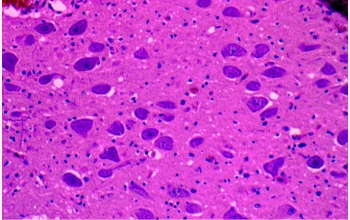Multimedia Gallery
Chronic Wasting Disease Research (Image 1)
This slide shows tissue from the brain of a healthy mule deer. Note the absence of lesions caused by Chronic Wasting Disease. This image was taken as part of a research project on "Chronic Wasting Disease in Wildlife: Responses to Changing Land Use," conducted by researchers from Colorado State University. The research is supported by National Science Foundation grant DEB 00-91961. [Image 1 of 2 related images. See Image 2.]
More about this Image:
Chronic wasting disease (CWD) of the deer family is a member of a group of infectious diseases caused by transmissible proteins called prions. Prion proteins accumulate in the brain of affected individuals, causing neural degeneration and inevitably, death. Similar diseases include scrapie in sheep and goats, bovine spongiform encephalopathy in cattle ("mad cow disease") and Creutzfeldt-Jacob disease in humans.
The only place in the world where these diseases are known to occur in free-ranging wildlife is in northeastern Colorado and southeastern Wyoming, where an epidemic of CWD has been ongoing in populations of mule deer and elk for at least two decades.
In their research on CWD, researchers from Colorado State University are studying the epidemic to learn how it is transmitted and whether or not it can be transmitted from animal residues that accumulate in the environment (urine, feces, saliva and carcasses). Principal investigator N. Thompson Hobbs and researchers Michael W. Miller and Elizabeth Williams will develop mathematical models to predict the spread of the disease as well as evaluate ways to contain it. The predictions of these models will be compared with field data on disease prevalence to identify the model that most reliably represents the behavior of the disease in mule deer populations. This model will be analyzed to understand how changes in land use resulting from rapid development are likely to affect the dynamics of the disease and to evaluate strategies for its management.
CWD poses a potentially major threat to members of the deer family throughout Western North America and although current evidence suggests that the transmission of the disease to people is unlikely, this possibility cannot be ruled out. (Year of image: 2003)
Credit: Photo by Elizabeth Williams
Images and other media in the National Science Foundation Multimedia Gallery are available for use in print and electronic material by NSF employees, members of the media, university staff, teachers and the general public. All media in the gallery are intended for personal, educational and nonprofit/non-commercial use only.
Images credited to the National Science Foundation, a federal agency, are in the public domain. The images were created by employees of the United States Government as part of their official duties or prepared by contractors as "works for hire" for NSF. You may freely use NSF-credited images and, at your discretion, credit NSF with a "Courtesy: National Science Foundation" notation.
Additional information about general usage can be found in Conditions.
Also Available:
Download the high-resolution TIFF version of the image. (3.7 MB)
Use your mouse to right-click (Mac users may need to Ctrl-click) the link above and choose the option that will save the file or target to your computer.



